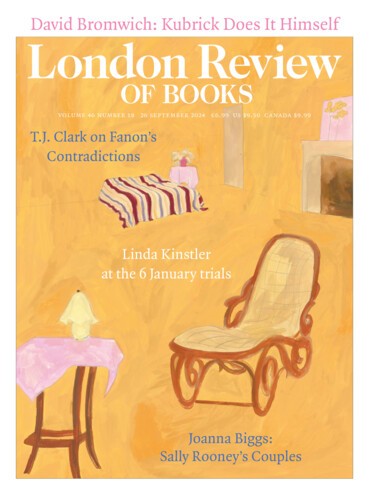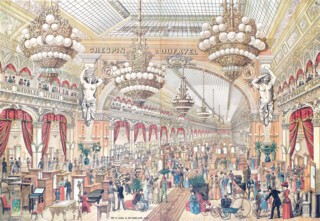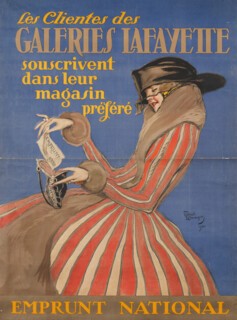The department store is dying. It’s not the only building type to find itself marooned by social and economic change, but it is the youngest. Castles and churches, stately homes, factories and warehouses have all had to adapt or die, but none is so emblematic of a single historic period. Spanning the high-water mark of the industrial revolution, the department store was the offspring and ornament of the most cosmopolitan cities of 19th-century Europe: London, Paris and the newly conjoined Budapest. Into the 20th century, streamlined glass and chrome in the Schocken stores of Stuttgart and Nuremburg led the advance guard of International Modernism. The decline began around the millennium. Already languishing in the face of out-of-town malls, online shopping and pedestrianisation, Covid brought on the collapse of what Save Britain’s Heritage in a recent report calls the ‘high street titans’. The closure of the Debenhams stores alone has left 13.6 million square feet unoccupied, adding to the hollowing out of town centres. It is not only the physical space that is empty. When Fenwick closed its London branch in February this year, there was a fin de siècle melancholy about the empty racks and the abandoned café on the first floor, the sense that something more than a shop was coming to an end.
The department store in its heyday was a world of its own, with a peculiarly female ethos. It’s in the Oxford Street Debenhams, which had been Marshall & Snelgrove, that Virginia Woolf’s Orlando finds herself in her last manifestation on 11 October 1928. Having travelled through time, she enters from the crowded street and the essence of department store joy comes over her. ‘Shade and scent enveloped her. The present fell from her like drops of scalding water.’ She rises up through the floors as she has travelled through the centuries: ‘Each time the lift stopped and flung its doors open, there was another slice of the world displayed with all the smells of that world clinging to it.’
With the end of the department store in sight, the Musée des Arts Décoratifs in Paris has put on an engaging and thoughtful exhibition about its beginnings, examining the grand magasin as social, architectural and economic phenomenon from its birth in the 1850s to its zenith in 1925, the year of the Exposition Internationale des Arts Décoratifs from which Art Deco got its name (until 13 October). The show opens, somewhat unexpectedly, with a display of maps, street plans and railway guides, for it was the reconfiguration of Paris in the mid-19th century, between the fall of the restored monarchy and the collapse of the Second Empire, when the great boulevards were cut through the city and the web of railway lines spread around it, that enabled the mushroom growth of an entirely new form of commerce. The story unfolds through gallery spaces where the historic arguments are illustrated with carefully lit displays of consumer goods, snippets of newsreel footage and the immense posters and glamorous advertising that promoted the grand magasin as the embodiment of taste and lifestyle for the aspirational bourgeoisie. While it is generally agreed that the origins of the department store lie in Britain, exactly where is unclear. The London outlets of the Manchester textile mills have been suggested as a precedent, while Save Britain’s Heritage cites Harding, Howell and Co.’s Grand Fashionable Magazine, which opened on Pall Mall in 1796, as the first real example. But that failed in 1820 and had no immediate successors. Perhaps Britain’s greatest contribution to an essentially French creation was the impression that Victorian London made on the future Napoleon III during his exile. Returning to France after the 1848 revolution, Louis Napoleon found Paris dowdy by comparison. The street pattern was still essentially medieval: there was nothing to compare with Nash’s great picturesque cityscape with its unfolding vistas rising from the Mall to the elegant shops of Regent Street and on to Regent’s Park.
The competitive urge was further piqued in 1851 by the Great Exhibition, which brought the world to London in its millions to see ‘the works of industry of all nations’. The display in the revolutionary Crystal Palace in Hyde Park could itself be seen as an ur-department store. Later that year, Napoleon mounted a coup which turned the Second Republic into the Second Empire and himself into emperor and set about making Paris ‘the capital of Europe’. He found an enthusiastic adjutant in Georges-Eugène Haussmann, prefect of the Seine district. Haussmann had no masterplan and wasn’t an architect, unlike Nash, but he was an adroit urban politician. Wherever he spotted an opportunity he made ‘skilful use’, as the catalogue puts it, of every variety of legal provision for compulsory purchase to push through wide, tree-lined boulevards and avenues that would not only add magnificence to the capital but ease traffic, clear slums and, not least, enable better police control. Over the next twenty years Paris nearly doubled in size, with development in the centre and expansion on the outskirts. By 1870 the population had reached two million, some twenty thousand buildings had been demolished and more than forty thousand built.
Haussmann’s Paris and the department store grew up together. The first of the Bon Marché shops opened in the year after Napoleon’s coup and was soon followed by Les Grands Magasins du Louvre, Le Bazar de l’Hôtel de Ville, Printemps and La Samaritaine. Paris held its own international expositions in 1855 and 1867, in which the distinction between showing and shopping was collapsed. Everything was for sale. Queen Victoria and the tsar both visited (Alexander II took a particular interest in the new sewerage system). The Second Empire witnessed the triumph of bourgeois taste and Haussmann’s Paris was seen as either the new Rome or the new Babylon, according to one’s politics. If Paris created the department store, the reverse was also to some extent true. The city’s reputation as the capital of style and fashion was bred in the grands magasins. Paris became, as the exhibition puts it, ‘une immense vitrine’. So much about the retail palaces was new, not least the concept of browsing. In contrast to the small specialist boutiques, all the goods were on display: they could be seen and even touched. Mass manufacture, free trade and rail freight made it possible to pile high and sell cheap. There was no entry fee, the prices were fixed and the facilities, which included lavatories and cafés, made them comfortable and respectable places for unaccompanied women to meet. The eponymous department store in Zola’s novel of 1883, modelled largely on the Bon Marché, is called Au Bonheur des Dames.
Architecturally, the department stores broke new ground. The impact came at first from sheer size as they ballooned out from the old streets into the spacious boulevards. The first stores in Haussmann’s Paris had to conform to the neoclassical style of his developments and so had small frontages with little space for window displays at ground level. They developed in dialogue with the exhibition buildings of successive decades, becoming similarly vast, galleried spaces. Cast iron construction and plate glass made possible little crystal palaces, arranged like theatres or cathedrals of consumerism. The interiors grew ever more colourful as the century wore on towards the Belle Époque. Even today, the shopper under the stained-glass dome at the Galeries Lafayette feels she is inside a giant Tiffany lampshade. In the new stores were born such novel retail phenomena as seasonal sales and mail order, while Frederick Worth emerged from the Gagelin emporium as the first named couturier and Paris began its rise to world capital of fashion. The streets that survived Haussmann had their share of the new shops. Au Coin de la rue, founded in the 1830s in the rue Montesquieu, transformed itself into a top-lit centralised court surrounded by galleries and stocked with more daring styles than could be seen at the Bon Marché. Over time, however, it became more difficult for the narrow sites in the 2nd arrondissement to compete with the ever expanding behemoths. The opening of the Avenue de l’Opéra in 1877 prompted questions in the Chamber of Deputies. There could be no reason for it, Adolphe Thiers suggested, other than a determination to ruin the business of the rue de Richelieu and rue de la Paix. But the grands magasins were unstoppable. The shadow they cast over the old quartier changed it as a new population of craftsmen and women, furnishers, packers and others whose livelihoods revolved around the department stores moved in. In 1881, a year before Zola’s Au Bonheur des Dames started to appear, Au Coin de la rue failed.
It had at least outlived the Second Empire, whose collapse saw Napoleon and Eugénie flee back to Britain leaving Paris to its fate. The Siege of Paris, the Commune and the establishment of the Third Republic, with Thiers as president, get scant attention in the exhibition, as if that unhappy winter of 1870-71, when the Seine froze, Parisians could communicate with the outside world only by carrier pigeon or balloon and were forced to eat most of the Paris Zoo was little more than an unfortunate hiatus in the rise of the grand magasin. And so perhaps it came to seem.
Zola’s novel is an anachronistic telescoping of past and present across the divide of 1870. It is supposedly set in the 1860s, but takes liberties with the details. As ever he researched his subject with journalistic thoroughness and the exhibition draws imaginatively on his notes as well as the novel itself. In correspondence with the architect of the rebuilt Samaritaine, Frantz Jourdain, who sent him detailed drawings, Zola said he couldn’t use them because they were too recent. In fact he did, inserting Jourdain in the novel as the young architect ‘par hasard intelligent’, who is enraptured by the latest building techniques and throws up a cast iron and glass structure over the ground floor of the store, where customers promenade through spacious galleries such as were not to be seen in the shops of the Second Empire. Like Orlando, the Bonheur des Dames is a time traveller. Zola’s concertinaing of pre and post-Haussmann Paris dramatised a real conflict. The novel’s violent confrontation between old and new proprietors foretold by not many years the actual uprising among shopkeepers of the 2nd arrondissement, who formed a union to call for laws to restrain the ‘maisons monstres’. Au Bonheur des Dames was topical, at least to those who knew Paris. So peculiar to the capital was the whole phenomenon of the department store that reviewers in the provincial press had to explain what the story was about.
The novel is the eleventh in his Rougon-Macquart series, coming after Pot-Bouille, in which the protagonist Octave Mouret expands his late wife’s silk shop. Mouret reappears having turned the shop into one of the rapacious grands magasins that have swallowed the surrounding sites. Mouret fuels his customers’ appetites, making them ever-more dependent on his store by introducing new attractions – a reading room, a home delivery service. He is a compound of several real proprietors, while Haussmann and Worth both feature, lightly disguised. Zola’s heroine, Denise Baudu, stands for thousands of young women who came from the provinces to find work in the department stores.
The exhibition is particularly strong on the daily lives of the shop workers, making use of Zola’s notes of interviews with employees at several stores. The hours were long and the pay low, forcing staff to rely on yet another innovation of the department store, the sales commission. But there were considerable compensations. The thirteen-hour days and strict standards of dress and morality imposed on the staff were mitigated by the provision of free uniform, board and lodging. It was not only for the customer that the grand magasin was a world of its own. Many stores were in effect mutual aid societies with pension and health schemes, sports clubs and retirement homes. By the standards of the day, a shop assistant’s life offered a good deal. Some of these enlightened employment policies were no doubt due to the fact that women figured prominently in the management of the department stores. Near the beginning of the exhibition we encounter the imposing, bombazined figure of Marguerite Boucicaut, one of the most influential. Like Denise Baudu, she came to Paris from the provinces when she was young and poor. Her life, as the show puts it, was a ‘mythe véritable’. She helped her husband to build up the Bon Marché shops and from 1879, as a widow in her sixties, assumed complete control, describing her regime as ‘socialism in the true sense’. Zola brings both sides of his argument together with a marriage between Baudu and Mouret: he the wealth creator and she its enlightened deployer. At its best, Zola concludes, the department store was a ‘phalanstère’. The phalanstery, France’s answer to the panopticon, an ideal building type for a utopian community, was conceived as a combination of phalanx and monastery. None was ever built in France, but arguably Le Bon Marché came close.
If he was ambivalent about the stores, Zola’s attitude to the women who shopped in them was even more uneasy. He saw what Woolf saw in their experience, but was baffled by it. He describes the shoppers promenading like queens, but queens in captivity, luxuriating in their glass and iron cage, haughty with the staff, pale with longing as they fondle the silks, worshipping in the new shops as they had once worshipped in church. He seems irritated by the experience that for Woolf was a kind of apotheosis, though unlike some of his contemporaries Zola did not seek to diagnose it. Many a confused male commentator of the later 19th century waxed eloquent about the dangers these palaces of commerce posed to female virtue, to home life and home economy. The exhibition catalogue has an entire chapter on ‘Kleptomanie, le mal des grands magasins’, discussing the way shoplifting, the perennial blight of large stores, was seen as another of the many nervous disorders to which the female mind was prone, a first step on the path to moral and mental collapse.
Yet still the social reach of the department store expanded: fashion shows, children’s departments, special Christmas displays, and, in due course, interior design departments. After the First World War, which the exhibition passes over with characteristic nonchalance, the grands magasins offered new ranges – the pullover, the tennis dress, the bathing costume, all designed for a female figure that had changed from the corseted customer for whom Mme Boucicaut catered into an androgynous creature with shingled hair. The show rises to a climax with the approach of 1925 as department stores, led by Le Printemps, began to establish their own applied arts studios. France’s determination to preserve its traditional craftsmanship in the face of German and British mechanisation was a matter of national pride. At the Exposition Internationale des Arts Décoratifs each of the major stores had its own architect-designed pavilion, each its individual slice of the world.
Send Letters To:
The Editor
London Review of Books,
28 Little Russell Street
London, WC1A 2HN
letters@lrb.co.uk
Please include name, address, and a telephone number.



